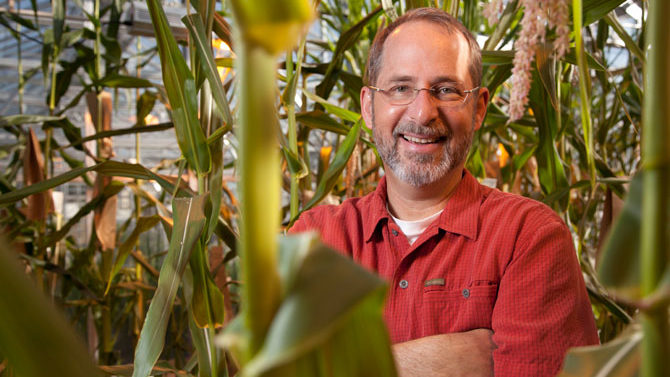Each year, as my eyes scan over the holiday feast laid out along the counter, I know I can count on finding a large casserole dish of creamed corn at the end of the line. My uncle has been making it just for me from Silver Queen white corn he grows behind his house since I was small enough to stand on his feet and dance around the living room.
The corn my uncle grows comes from a hybrid seed, developed by a private seed company, bred to grow well in Southern soil and withstand disease. But as communities in Georgia and across the globe begin to face new pests, diseases and changing weather patterns, the tiny seeds that yield our crops will need to adapt.
Just 10 miles from the nearest family farm in Athens, researchers at the University of Georgia are working to ensure that some of our favorite foods continue to make it to our plates.
Kelly Dawe is aware that corn gets a bad rap in the U.S. As a domestic crop, it’s often associated with Monsanto and anti-GMO sentiments, “but there [are] a lot of people who appreciate corn for its great beauty and history of feeding the world and the world’s animals,” he says. Dawe is one of them.
“The corn I know is not poison. The corn I know is this beautiful, productive plant that was developed by humans and is still being heavily developed by humans. Some of the best scientists in the world are working on this species. It has great genetic power,” says Dawe, a plant geneticist at UGA.
Dawe is leading a large-scale project funded by the National Science Foundation to analyze and assemble the corn genome. The approach is similar to how scientists sequenced the human genome, beginning with one person and gradually gathering more genetic information from more people over decades to form a more complete picture.
Dawe’s team is planning to map a corn “pangenome” in just two years. The pangenome will incorporate 26 different genetic lines of corn, assembled to represent corn’s genetic diversity.
This project will illuminate how corn varieties from different parts of the world adapt to their environments, down to the genetic trait responsible for the adaptation. That kind of knowledge is powerful when it comes to developing new seeds to meet the challenges faced by new disease or a change in environment, says Scott Jackson, another plant geneticist at UGA, who works with rice and peanuts.
“Many small farmers who rely on what they farm to subsist are affected by what we do,” says Jackson. “We’re trying to capture what nature’s done using modern tools to improve the crops we eat, which, I think, is important and valuable.”
His team finds ways to tap into desirable traits, like the ability to bounce back after an early flood found in domesticated rice’s wild cousins, and introduce them to the rice we eat.
The results of academic genetic analysis are often public knowledge, which is important, says Dawe. “Whenever we make public resources, some of the first and probably the most important people to use that information are the private companies,” he says. “There is a connection, usually informal, between academia and industry, which is important, because why would we do this if people didn’t use the information to make better food?”
For now, the news of fully sequenced crop genomes is more likely to excite seed producers and large-scale Midwestern farmers than the small family farms we know here. “That technology and information will filter down to crops grown on a much smaller scale, such these local crops, but it takes people working in these areas, scientists using genetic information, to create new varieties,” says Jackson.
While heirloom varieties hold a special place in the heart and on the palates of many, these crops are susceptible to drought, disease and pests. Adopting new resistant varieties, says Jackson, is often a more sustainable way forward.
Like what you just read? Support Flagpole by making a donation today. Every dollar you give helps fund our ongoing mission to provide Athens with quality, independent journalism.










